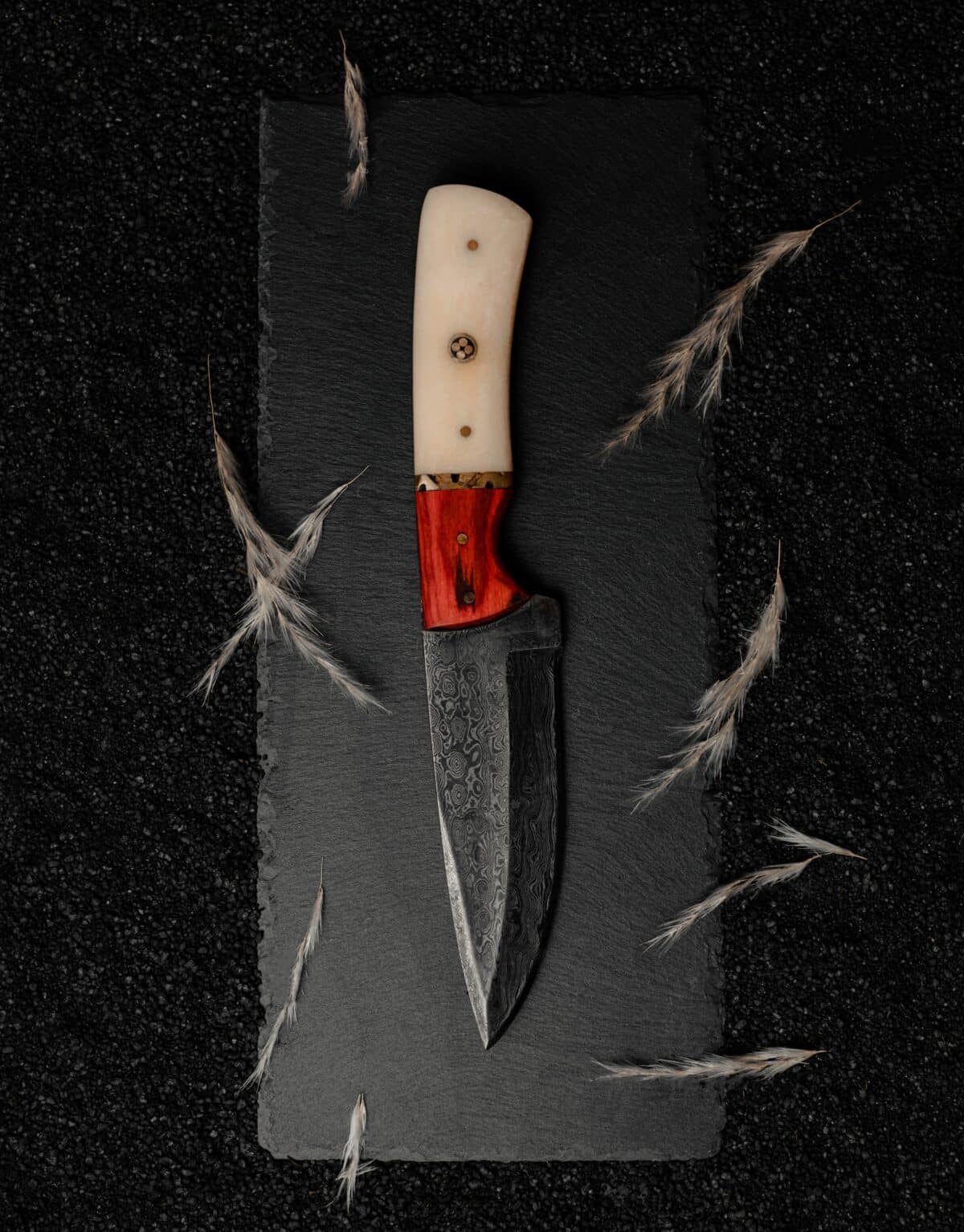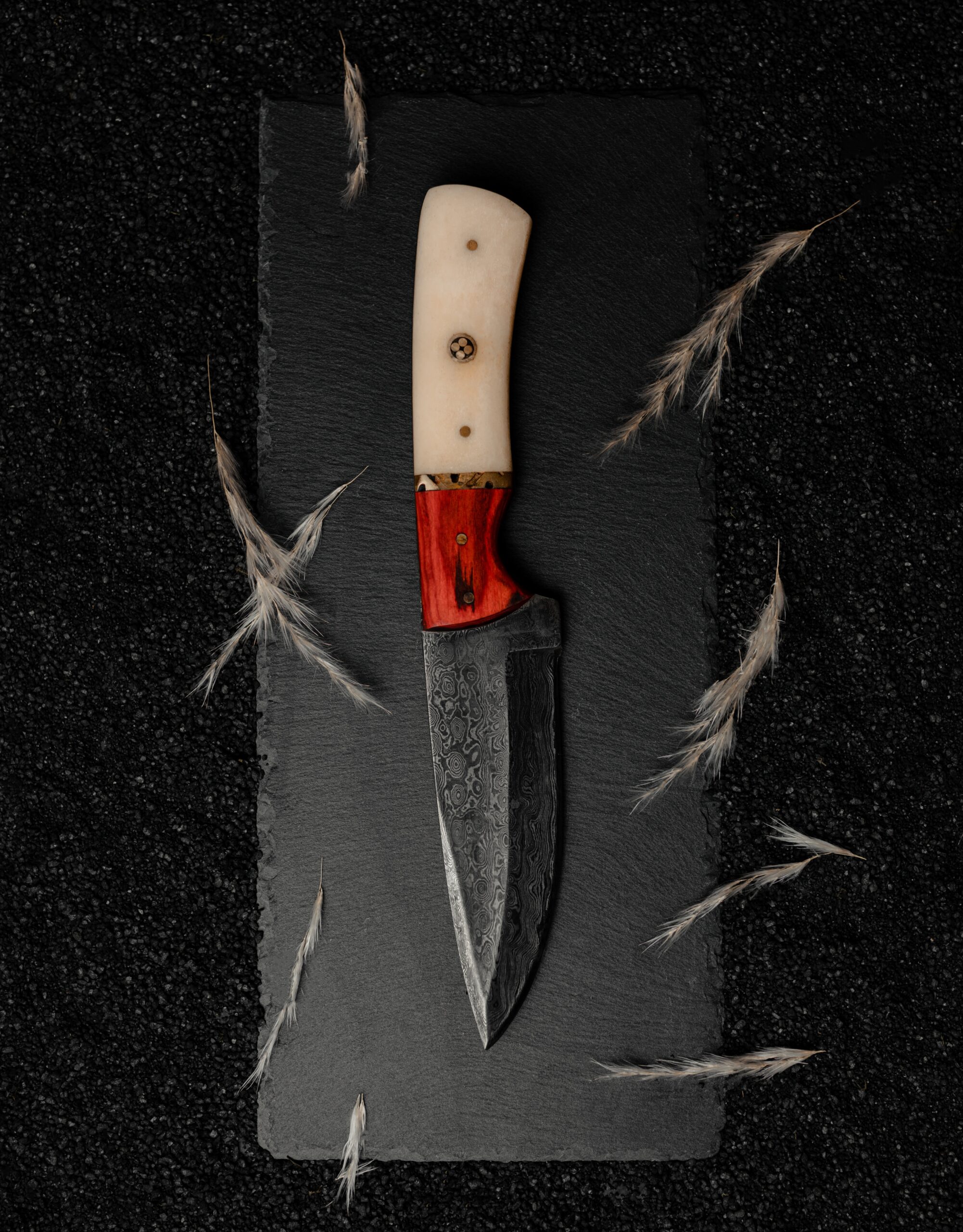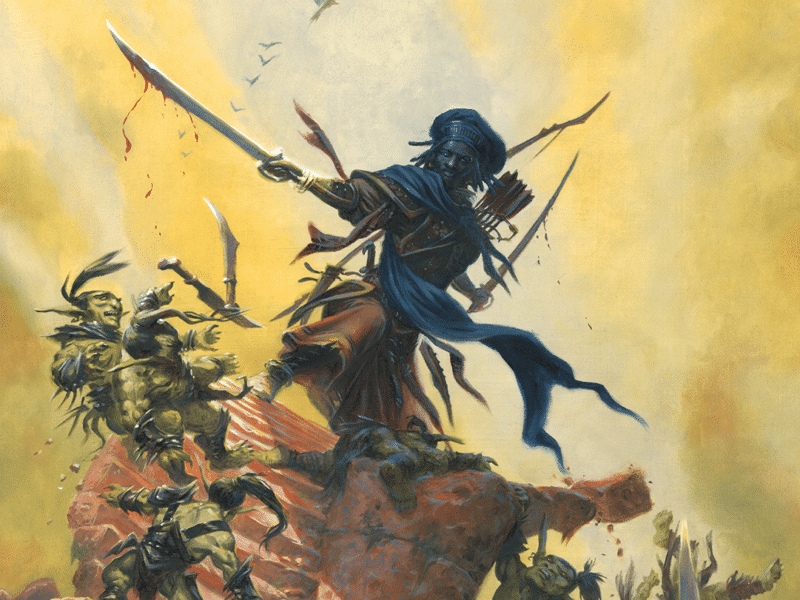As Dungeons & Dragons is, at heart, a combat-oriented roleplaying game, it’s no surprise that there’s a wide array of weapon available to the characters. As most characters are budding fantasy heroes or one type or another who repeatedly set out on dangerous journeys in search of gold and other treasure, being proficient in combat is critical.
What’s more, as a character gains levels throughout a campaign, they tend to face ever nastier and tougher opponents. Regardless if these are hulking, slobbering monster or cunning masterminds hold up in hard-to-reach lairs, they often have one thing in common: their hit points increase. For this reason, it’s easy to see why many players obsess over their characters’ choice of arms, and spend a lot of time trying to optimise their damage output. Consequently, weapons that deal massive damage are preferred by many classes that focus on melee and ranged combat. In other words, a wise adventurer doesn’t bring a knife to a battlefield.
Or should they?
The knife – or dagger, to use a nomenclature more appropriate to a fantasy RPG – is a rather curious weapon in D&D. In my experience, many characters, especially rogues, start out with a dagger in their belt, often because their budgets are limited or due to restrictions of their class. However, as they gain levels, the daggers are quickly discarded or demoted to their backpacks in favour of swords and axes. Even magic daggers, especially those that require attunement, are typically tucked away unattuned or sold off at the nearest market. At best, they’re reduced to a character’s last resort in case they somehow lose all their other weapons. This is understandable: in a world where dragons are real, dishing out colossal damage becomes a priority. But it’s also a pity, because in this writer’s opinion, daggers have a multitude of uses – practical as well as aesthetical!
In this article, I will take a stab (sorry!) at listing several arguments for why every self-respecting adventurer should have at least one dagger in their arsenal. I’ll also list a handful of interesting magic daggers that can be found in the core rulebooks and beyond. So come along and let’s dive into the possible uses of this tiny but underappreciated weapon!

It’s dead simple
This isn’t a benefit when it comes to damage-dealing but still a feature that’s worth mentioning: daggers are available to all classes. Which means that in the likely event that you come across that extremely powerful dagger, and happen to be playing a character of a class that can use only simple weapons, you can use it in combat right away. And there are mightily dangerous daggers out there – for example, there’s one in our adventure Secrets of the Drow!
This thing doesn’t weight anything
This is also a Daggers are rated as Light in the rules, which makes sense given their size, so they’re a choice for characters who are fighting with two weapons. It’s true that both scimitars and shortswords are better options for your off-hand in terms of pure damage-dealing as they also are light weapons (and they also have the Finesse property – more on this below), but importantly, a good DM might argue that in-game, these two weapons are heavier as well as larger, which means they’re limited in certain other ways that I’ll elaborate on below.
Fighting with flair and finesse
Now we’re starting to home in on the interesting aspects of daggers! Weapons with the Finesse property are rather few, and the list includes daggers, shortswords, rapiers, scimitars, and whips. Among these, we find that only daggers are both Simple weapons and possible to use as ranged weapons by throwing them in your opponent’s face (or tentacle, gigantic eye, incorporeal torso, et cetera – this is Dungeons & Dragons, after all!).
Enter the rogue. Members of this class and its myriad subclasses are likely to be interested in daggers as they enable their dreaded sneak attacks. There are other weapons that can be used for sneak attacks too, such as rapiers and shortswords – but these are larger and more conspicuous, and many rogues lean towards more discreet weapons.
And there’s more: as the additional bonus damage from sneak attacks applies to ranged attacks as well, there’s all the more reason to pack several daggers in your rogue’s belt. Additionally, of the weapons listed above, only shortswords and daggers can be used for off-hand attacks with using up feats or having other special abilities. As the basic damage die involved in these attacks is small, but the potential sneak attack damage is huge, there’s plenty of reason for rogues to look at two-handed fighting. Should there be poison involved, a rogue might be even further interested in getting in as many attacks as possible every round.
Trust me, I’m unarmed
Now were getting into the benefits of daggers that have more to do with roleplaying and dungeon mastering rather than rules: a dagger’s size and look. Before proceeding, let me repeat that the following aspects of daggers may not be of any use in a campaign that revolves around by-the-core-rules-and-only-the-rules dungeon crawling. However, in adventures that focus on social interaction between player characters and NPCs, or when you have a DM who pays a lot of attention to details and behaviours that aren’t necessarily covered in the rulebooks, the situation can be very different.
We’ll start with the size. In contrast to almost all other weapons in Dungeons & Dragons, daggers are small. Some are on the big side, others are tiny, but they’re generally less obtrusive than their larger cousins shortswords.
Better still, daggers can take shapes and forms that make them even less suspicious. Rangers routinely carry hunting knifes, chefs naturally own a range of blades, and carpenters will have carving knifes or similar tools. There are also letter openers, ceremonial and decorative daggers, all of which can hide in plain sight on stands or tables – or even on a character!
As such, DMs may allow daggers to be concealed more readily than other weapons, for example by making them more difficult for guards to spot or notice if they search a character. That way, the characters can get away with packing daggers in places where weapons normally aren’t permitted – courts, balls, vaults, and so on.
Stabbing in style
And lastly but certainly not least, there is the delicate matter of style. Swords are impressive, axes are intimidating, bows are graceful, maces are classy, and lances are, well very long.
But daggers are different. Yes, they’re small – but as noted above, they’re more personal. In difference to huge weapons, daggers are often carried around all the time, so they are by default closer to a character. What’s more, an ornate two-handed sword is imposing, for sure, and a massive greataxe is a standout item in any gathering – but a stylish and custom-designed dagger speaks of other qualities, such as taste, expertise, and discreetness.
This applies to using them too! Overly muscled warriors who swing colossal blades might be terrifying, but someone who wields a dagger – or better still, two – with flair and grace radiates a dissimilar type of menace. And there’s no question which of the two opponents you would prefer not to show up in a narrow alley at night!
It might be small, but its powers aren’t!
Let’s dive into the magically enhanced daggers that are available in the core rules, later modules, and other places!
Dagger of Venom
Somewhat disappointingly, the Dungeon Master’s Guide features one magic dagger. That’s right – a single dagger, squeezed in between a plethora of swords and axes and only an archmage knows what else. And it’s not a particularly impressive one either. It grants the wielder a +1 bonus to attack and damage rolls, and the wielder can also use 0an action to cause a not-especially-powerful poison to stream out and coat the blade – and that’s a once-per-day use. Good for sneaking a poisoned dagger into a place where people are on the lookout for such things, but beyond that, the dagger is not exactly something you’d risk facing a dragon for. Or even a goblin. However – this item is a classic one, so I reckon it’ll be found in D&D for ages to come.
Dagger of Blindsight
This is an interesting one! Found in Waterdeep: Dungeon of the Mad Mage, this dagger not only looks seriously snazzy – it also grants its wielder blindsight up to 30 feet. This might not sound impressive, but it’s a colossal boon in many circumstances! Fighting in an unlit dungeon, thick fog, dense forests, or even magic darkness? Not a problem with this in your hand.
Bracer of Flying Daggers
Not a dagger per se, this item is featured in Waterdeep: Dragon Heist and opens to some seriously spectacular film-like action. The bracer looks like it has lots of slim daggers strapped to it. As an action, the wearer can pull two daggers from the bracer and making a ranged attack with each of them. The daggers disappear whether they hit or miss – and the bracer has an endless supply of the daggers!
Shadow Drinker
Dreamed up by the great Griffon’s Saddlebag and readily found online, this is one wicked weapon. It grants an attuned wielder a +1 bonus to attack and damage rolls, but that’s only the start. If you hit a creature with the dagger, you draw the creature’s shadow into the dagger for up to ten minutes. During that time, you’re invisible in dim light or darkness, and if you hit with an attack while invisible, you deal an additional 1d6 necrotic damage – or 2d6 if the attack is made against the creature whose shadow you stole. Perfect for assassins or others who strike from the shadows!
Bookmark
Yes, it’s an odd name for a magic dagger – especially as powerful as this one! From Tomb of Annihilation, this is a mighty +3 dagger, but there’s much more to it. For example, you can use a bonus action to shed bright light out to 20 feet and dim light out to another 20 feet, cause the dagger to point north, cast dimension door once per day, or cast compulsion – but only at spiders! Quite useful for any survival-oriented adventurer!
So there you have it: daggers are far from forgettable weapons carried only by novice adventurers! On the contrary, as they’re small and discreet, they have specific uses, and they’re perfect for tying into your character’s backstory – so don’t swap them out of your inventory just to save space. And finally, when fighting with daggers, always remember to pose. This is very important.







